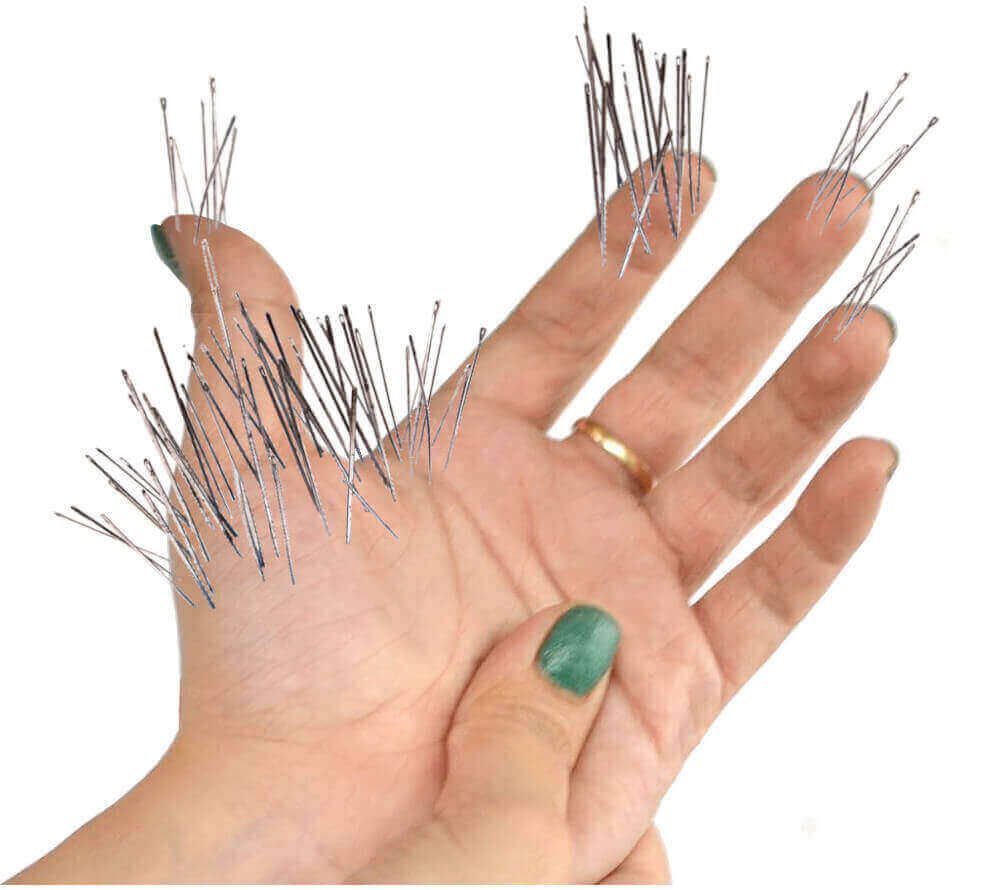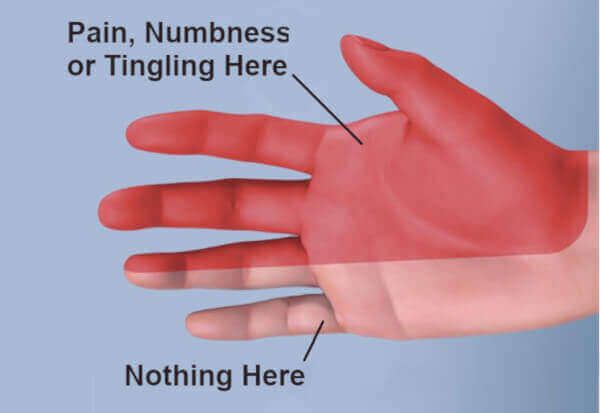Yoga for Carpal Tunnel Syndrome Relief
Table of Contents
- What is carpal tunnel syndrome?
- Carpal tunnel symptoms
- Cause of carpal tunnel syndrome: swollen tendons
- Why carpal tunnel surgery usually fails
- Reliable non-surgical remedies
- Yoga for carpal tunnel syndrome
- Yoga routines
- Add massage to your yoga routine!
- How is massage beneficial?
- Summary
What is carpal tunnel syndrome?
Carpal tunnel syndrome most often results from using your fingers and hands repetitively, especially with forceful motions. Gripping a shovel or a
hairbrush for long periods of time, or even using a scissors are common examples.
But a large percentage of people develop carpal tunnel syndrome without ever engaging is such activities. Obviously, there’s much to learn about this disorder.
Ordinary hand or finger pain is common. Most people have it at one time or another in their life. Overworking or straining your hand on the
job (or when gardening,
knitting,
guitar playing, etc.) can produce pain.
But if the pain is
persistent
it may not be ordinary hand or finger pain due to stress and strain. And if you ALSO feel numbness or tingling, then it’s likely
not
ordinary hand strain at all.
According to the
American Academy of Orthopedic Surgeons (AAOS), if one or more of those symptoms persist, then you likely have
carpal tunnel syndrome. That means you’re in the company of 5 million Americans with the same problem.
Carpal tunnel symptoms
Carpal tunnel syndrome is one of the most common neurological conditions today. Its primary symptoms are hand or finger:
Along with the above, other unpleasant sensations can also manifest. These include itchiness, soreness, puffiness, and loss of temperature sensitivity. Sometimes patients see swelling in their fingers.
Any of the above sensations can be mild, moderate or severe. Actually, many people with carpal tunnel syndrome have such severe symptoms they can no longer perform the demands of their job.
In the
early stages, carpal tunnel syndrome usually comes and goes. This distinguishes it from
wrist tendonitis which persists for a while, then resolves with rest. A simple
self-test can tell the difference between carpal tunnel and tendonitis.
In the early stages, you usually notice carpal tunnel symptoms at night as you’re
trying to sleep. Patients often report having to wake up and shake out the numbness in their hand or fingers.
As carpal tunnel syndrome becomes more
severe, symptoms persist into the day with almost no relief. The intensity of symptoms (usually pain or numbness) increases to seemingly unbearable levels.
Cause of carpal tunnel syndrome: swollen tendons
Carpal tunnel syndrome begins with
microscopic rips on the tendon's surface. These result from over-stressing the tendons controlling your fingers. The rips then create
collagenous adhesions. The adhesions make the tendons sticky and restrict their movement. In other words, the adhesions prevent tendons from gliding smoothly.
Such restrictions to movement produce irritation & inflammation. This manifests as tendon swelling.
Swelling is accumulation of fluid pressure around the tendons and their coverings or sheaths.
Anywhere else in the body, such swelling resolves with just a little rest. But when the swelling occurs inside the wrist joint, it’s a totally different matter.
Swollen tendons push on the
median nerve deep inside the wrist joint, in a space called the “carpal tunnel”. Eventually, the swollen tendons crush the nerve. This is what causes all of the pain, numbness, and other unpleasant symptoms of carpal tunnel syndrome.
Why carpal tunnel surgery usually fails
To permanently relieve the inflammation, just eliminating pressure on the median nerve (like surgery does) is not enough. In fact, that’s the main reason carpal tunnel surgery
fails about 50% of the time. Surgery reduces swelling for a short amount of time. But it doesn't attack the
source
of the swelling (i.e., the adhesions).
That's why tendon swelling invariably returns after surgery.
And this is why
carpal tunnel surgery is no longer used as the first treatment method for carpal tunnel syndrome.
For any remedy to be effective and permanent, it must eliminate the tendon adhesions and restrictions.
This is why yoga for carpal tunnel syndrome IS so effective. The yoga stretches break up the adhesions and restrictions by tugging and pulling the tissues near the tendons. With adhesions eliminated, there's no longer irritation and swelling.
That means the median nerve is no longer crushed.
Reliable non-surgical remedies
Medicine has changed dramatically over the last 2 decades. In the past, chances were that if you saw a
doctor who diagnosed you with carpal tunnel syndrome, you immediately received two options.
- Wear a brace at night (nocturnal bracing) for a few months and see how it goes. (This is actually very good advice.)
- Have carpal tunnel surgery right away.
Thankfully, this “pick one” attitude toward carpal tunnel syndrome has changed.
Carpal tunnel release surgery is still the most common major operative procedure in the USA. But doctors are no longer rushing to recommend it as a
first
option, like before.
Why?
We now have verified, non-surgical options for treating carpal tunnel syndrome. And with the high failure rate of surgery, why not use these non-surgical remedies first? In fact, the
American College of Orthopedic Surgeons (AAOS) recommends it in their new guidelines.
These non-surgical options are
natural remedies. They’re widely accepted as ways to give lasting relief from carpal tunnel syndrome. The most effective options include:
- Yoga
- Night bracing
- Targeted stretches
- Myofascial massage
Yoga for carpal tunnel syndrome
Yoga is
known to relieve a host of neurological disorders. Patients who practice yoga for carpal tunnel syndrome generally report that certain exercises will eliminate symptoms permanently. And such anecdotal claims are strongly supported by
medical research.
Yoga works well to eliminate carpal tunnel syndrome because it breaks up the adhesions on tendons. This relieves restrictions and allows tendons to glide more smoothly. That, in turn, reduces tendon inflammation and swelling.
Of course, the result is the median nerve is decompressed. And that's when symptoms resolve.
Yoga is especially suited for reducing pain and increasing hand strength. Two separate
clinical trials showed patients could significantly reduce carpal tunnel pain in as little as 8 weeks. This was compared to patients who only splinted their wrist.
As a result of the large volume of clinical evidence, the
Journal of the American Medical Association concludes that those who practice yoga (and specifically perform yoga exercises focusing on the
upper body) will show marked symptoms relief within two months.
Yoga routines
To be effective,
yoga exercises should be performed as often as possible. Actually, they should part of a
healthy lifestyle to be most beneficial.
Most physical therapists and yoga instructors advise a
twice daily regimen of yoga exercises for maximum effectiveness. The most potent yoga exercises emphasize that you open, stretch, and strengthen the joints of your entire upper body, not just your wrist.
There are 4 yoga poses particularly effective in relieving carpal tunnel syndrome. Common to all of these poses is prolonged wrist stretching in the extended position. These are:
- Cat and Cow
- Upward Facing Dog
- Bharadvaja’s Twist
- Prayer Position
The only catch to effectively using yoga for carpal tunnel syndrome is that it must be
part of your daily routine. Yoga cannot be performed only when you have symptoms, but every single day. After several weeks or even months of yoga exercises, symptoms gradually lessen and eventually disappear completely.
Continued adherence to yoga almost never allows symptoms to return.
Yoga exercises are also effective for the purpose of
meditation. This provides the person suffering with carpal tunnel syndrome a two-pronged benefit from one simple technique.
Add massage to your yoga routine!
Massage is also highly effective against carpal tunnel syndrome for the same reason as yoga. Massage breaks apart adhesions that cause tendon movement restrictions. This is the key to allowing tendons to glide smoothly and reduce inflammation and swelling.
To be most effective, a specific technique called
myofascial release massage should be used. The reason is because of how this type of massage interrupts tissues below the skin. It requires
counter-rotating fingers to deeply twist and knead the skin over the flexor tendons.
Obviously, you need two hands to perform this. So a willing partner is required.
Or you can use the CarpalRx to do it for you.
How is massage beneficial?
The kneading motion forces tendons and sheaths to rub and scrape against each other. This effectively disrupts the adhesions holding them together. With repeated therapy, a patient’s
symptoms are significantly reduced. In fact, pain and numbness are so improved that it can be
confirmed by EMG testing.
Another benefit of myofascial release massage is that it facilitates
drainage of excess fluid inside the wrist joint. Tendon swelling is generated by excess fluid build-up. If you drain the fluid, you lessen the fluid pressure on the median nerve. This added benefit of massage is felt quickly because as fluid drains away, symptoms dwindle noticeably.
An additional benefit of myofascial release massage is
increased blood flow to the wrist. The tendon healing process requires both fluid drainage as well increased blood circulation. The more blood flowing through the healing area, the faster nutrients can
replace damaged or worn out structures.
While
multiple studies confirm the effectiveness of massage, you only need to ask physical therapists and massage therapists how they best deal with carpal tunnel syndrome. The overwhelming majority use myofascial release massage ALONE as their “go-to” remedy.
Finally, like yoga, massage is not an overnight treatment process. You must perform myofascial release massage
at least once daily, and for at least 4 weeks.
Summary
Yoga for carpal tunnel syndrome can effectively eliminate symptoms with ongoing practice. Unlike surgery, yoga targets the root cause of carpal tunnel syndrome; tendon adhesions causing swelling. Yoga effectively breaks up tendon adhesions and loosens restrictions. This allows tendons to glide more smoothly. As a result, the irritation and inflammation which causes tendon swelling diminishes. Then the terrible symptoms of carpal tunnel syndrome disappear.
About















